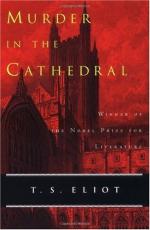|
This section contains 282 words (approx. 1 page at 400 words per page) |

|
Murder in the Cathedral Summary & Study Guide Description
Murder in the Cathedral Summary & Study Guide includes comprehensive information and analysis to help you understand the book. This study guide contains the following sections:
This detailed literature summary also contains Bibliography and a Free Quiz on Murder in the Cathedral by T. S. Eliot.
In 1163, a quarrel began between the British King Henry II and the Archbishop of Canterbury, Thomas Becket. The men had been good friends, but each felt that his interests should be of primary concern to the nation and that the other should acquiesce to his demands. Becket fled to France in 1164 in order to rally support from the Catholic French for his cause and also sought an audience with the Pope. After being officially (although not personally) reconciled with the King, Becket returned to England in 1170, only to be murdered as he prayed in Canterbury Cathedral by four of Henry's Knights, Three years later, he was canonized and pilgrims—Henry among them—have made their way to his tomb ever since.
The allure of such a story for a dramatist is obvious: there is a great conflict between human and divine power, a strong central character and a number of complicated spiritual issues to be found in his death. In 1935, T. S. Eliot answered this "calling" to compose a play for that year's Canterbury Festival; the result was a work that revitalized verse drama—a form that had not been widely employed for almost three hundred years. Critics praised Eliot's use of verse and ability to invest a past historical event with modern issues and themes, such as the ways in which lay persons react to the intrusion of the supernatural in their daily lives. In part because it is a religious drama which appeared long after such plays were popular, Murder in the Cathedral is still performed, studied, and regarded as one of Eliot's major works, a testament to his skill as a poet and dramatist.
Read more from the Study Guide
|
This section contains 282 words (approx. 1 page at 400 words per page) |

|



